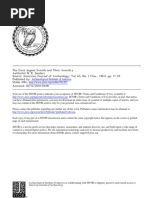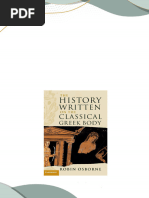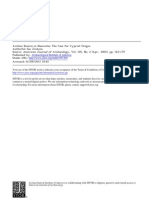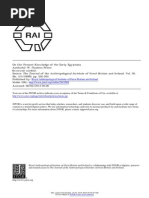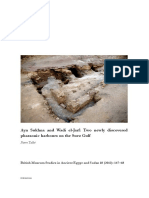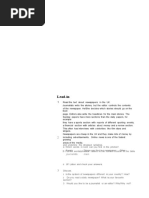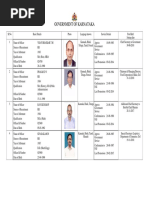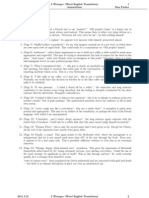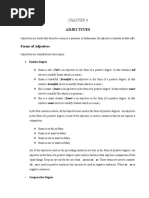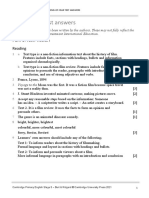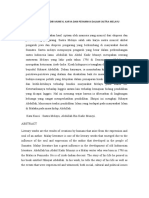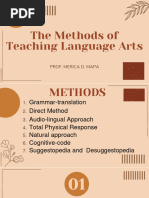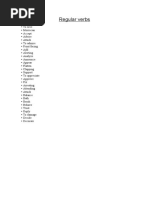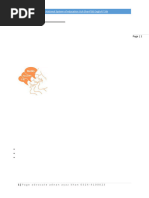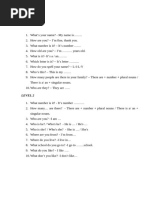41724744
41724744
Uploaded by
Gokhan MermiCopyright:
Available Formats
41724744
41724744
Uploaded by
Gokhan MermiCopyright
Available Formats
Share this document
Did you find this document useful?
Is this content inappropriate?
Copyright:
Available Formats
41724744
41724744
Uploaded by
Gokhan MermiCopyright:
Available Formats
IRON IN THE NAPATAN AND MEROITIC AGES
Author(s): G. A. Wainwright
Source: Sudan Notes and Records , 1945, Vol. 26, No. 1 (1945), pp. 5-36
Published by: University of Khartoum
Stable URL: https://www.jstor.org/stable/41724744
JSTOR is a not-for-profit service that helps scholars, researchers, and students discover, use, and build upon a wide
range of content in a trusted digital archive. We use information technology and tools to increase productivity and
facilitate new forms of scholarship. For more information about JSTOR, please contact support@jstor.org.
Your use of the JSTOR archive indicates your acceptance of the Terms & Conditions of Use, available at
https://about.jstor.org/terms
is collaborating with JSTOR to digitize, preserve and extend access to Sudan Notes and Records
This content downloaded from
88.246.199.217 on Sun, 19 May 2024 19:23:44 +00:00
All use subject to https://about.jstor.org/terms
IRON IN THE NAPATAN AND MEROITIC AGES
By G. A. Wainwright
The Napatan Age
The pyramids of both the earlier and later capitals of Ethi
Napata and Meroc, have been, cxcavated. Hence when the
results are published in detail we shall have a complete record of the
development generation by generation of the objects and materials
that were regularly deposited under each of them at their foundation.
Model tools of bronze and iron are among such deposits.
At Napata the scries of pyramids begins with Kashta, c.75 o>-j^
B.C., and bronze models are the regular thing until at last after four
hundred years we reach Pyramid xiii, that of Harsiotef, c. 397-362 B.C.
Here at last iron models are found for the first time among the usual
bronze ones. Iron as well as bronze models are similarly found in
Pyramid xiv1, that of Akratan, to whom Reisner allots the years
342-328 B.C., and whom he puts as the immediate predecessor of Nastas-
en, with whom the dynasty of Napata came to an end in c.308 B.C.2
Pyramid' xv, that of Nastasen himself, had no deposits,3 though no
doubt, if it had had, it would have have had some iron like those of
the two previous kings. Thus, the valuable point is made that in
the period c.750-308 B.C. iron does not appear at Napata until the
years between c. 397-362 B.C.
The evidence of the deposits in the pyramids is confirmed by the
fact that Tirhakah's (688-663 B.C.) foundation deposits in his temple
i. Reisner in Harvard African Studies ii (1918) pp. 59, 43, and PI. viii, 2.
2. Id. in J.E.A., ix (1923) p. 75. In the original publication where the iron is
mentioned, Pyramid xiv is spoken of as belonging to Piankhalara ( ?) , who reigned between
Harsiotef and Nastasen (Harvard African Studies ii, p. 63). Piankhalara now proves to
have been buried in another cemetery, that of Kurru (J.E.A.,. ix, p. 75 No. 24), which
does not seem to have been published yet.
3. Id. in Harvard African Studies ii, pp. 41, 59.
This content downloaded from
88.246.199.217 on Sun, 19 May 2024 19:23:44 +00:00
All use subject to https://about.jstor.org/terms
6 SUDAN NOTES AND RECORDS
at Napata were of gold, silver, bronze and lead,4 but t
Nor was there any iron, though there was plenty
deposits óf his next succášsoř, Atíanersa, c. 653-643
the great days of Ethiopia, those of Shabaka and Tir
B.C., she was clearly as much, or more, in the Bronz
It is a warning against giving too early a date to the scra
now come under discussion.
The first of these is the iron from the Sanam cemetery at Napata.
Here the iron proves to be somewhat earlier than that of Harsiotef,
indeed the few earliest specimens are likely to be as much as two hundred
years earlier. To obtain results it is necessary to divide the graves
into as many groups as possible with their sequence. Such indications
as there are seem to be
1. Cave graves are the earliest, beginning not earlier than Piankhy,
c.744-710 B.C.«
2. The larger rectangular graves,7 on the whole are somewhat
later.
Both these classes contained mummies, or bead network or car-
tonnage, indicating that mummies had originally been there.» Pottery
of Type I was often found in these graves. It is dated by the found-
ation deposits of the pyramids at Napata (Nuri), where it disappears
after Amtalqa, c. 568-553 B.C.» These graves may, therefore, be
said to be earlier than that date.
3. Extended and contracted burials in the sand. These had
not bèen mummified.10
The contracted burials almost monopolize the Type III pottery
in all its varieties. This dates the burials as not earlier than the
4. Griffith in L.A.A.A. ix, p. 81 and PI. xxii. This particular portion of the great
site at Napata is called Sanam, pp. 67, 79.
5. Reisner in I.E. A., v, p. 107.
6. Griffith in L.A.A.A., x, p. 83.
7. Cf. 'à.,-op. cit., pp. 83, 85, 89.
8. pp. 84, 85.
9. pp. 86, 89. Cf. also p. 87 where the mummies are thought roughly to date trom
Piankhy to Amtalqa.
10. p. 89.
This content downloaded from
88.246.199.217 on Sun, 19 May 2024 19:23:44 +00:00
All use subject to https://about.jstor.org/terms
IRON IN THE NAPATAN AND MEROITIC AGES 7
reign of Amtalqa, c. 568-553 B.C. and probably later, for this p
only begins in the foundation deposits of this king's pyram
Napata (Nuri).11 It seems probable, however, that some
extended non-mummified burials begin in the period before Am
4. The end of the cemetery seems to come perhaps a cen
after the Persian conquest of Egypt.13 That would p
to about 400 B.C., and a hundred years before the tr
ference of the capital from Napata to Meroe.
With this meagre skeleton of a chronology we must do wh
can at assessing dates for the few scraps of iron which were fo
the cemetery. The following is the list of graves with the iron
found in them separated into those which are probably before A
and those which are probably after his time. Each group is arr
as far as possible in order of the graves' degradation, and he
one supposes, of their probable sequence. The page number is a
in each case to facilitate reference.
Grave Iron object Description of Grave and Burial ! Page
Before Amtalqa i.e. before c. 568-553 B.C.
but well after Piankhy, c. 744-710 B.C.
968B bangle small cave j 162
714 arrow rect. brick, cartonnage, j 157
pilgrim flasks. :
523 tweezers rect. brick, mummy. 152
963 remains. rect. brick, rich deposits, 86,120,162.
ointment spoon.
587 arrow brick, extended. 153
701 hook small brick, extended. 126,157
162 tweezers rectangular. 145
After Amtalqa i.e. after c. 568
but before c. 400 B.C.
706 large tweezers, ' sand, extended. ! 126,157
razor (?)
771 tweezers sand, extended. ! 158
646/7 razor j sand, rect. contracted ' 126,154
. Type III pottery.
671 hoop staples rect. contracted. 155
362/1 razor sand, contracted. j 126,149
Type III pottery.
899A j small tweezers ¡ sand, contracted. 126,161
632 small earrings | shallow, sand, roughly rect., 123,153
contracted.
1042 razor irregular, contracted. 164
768 2 bangles small irregular, contracted. 158
1366 blade sand. 168
77 tanged spearhead shallow 126,143
ll> p. $9. 12. p. 89. 13. p. 90.
This content downloaded from
88.246.199.217 on Sun, 19 May 2024 19:23:44 +00:00
All use subject to https://about.jstor.org/terms
8 SÜDAN NOTES AND RECORDS
On considering the above table certain point
In the first place the majority of the graves th
datable to a time after Amtalqa. That this a
specimens is in general correct is supported by t
with the exception of one small grave, No. 968 B
caves, which form the earliest group of all.14 N
that it does occur to some extent in the rectan
which would be a slightly later group, but, as
the iron probably comes mostly at the end of th
hand we find that most of the iron comes from the extended and con-
tracted burials in the sand. These are the latest of all the graves.15
The lateness of the appearance of iron in the series of rectangular
bricked graves is suggested by its general absence in those which con-
tained the Syro-Cappadocian cylinder seal and the piilgrim flasks.14
It seems probable that these objects would have been imported in the
period of Shabaka and Tirhakah, say about 710-663 B.C., when
Ethiopia was in close contact with the Assyrians. With only two
exceptions the cylinder seal and the pilgrim flasks were found in
rectangular graves with extended burials ; one even had a mummy,
and practically all the graves were bricked. Only one pilgrim flask,
No. 1033, came from a contracted burial. The indication, therefore,
is that the graves with northern imports, belong to the earlier, but not
the earliest, portion of the cemetery, and it is worthy ci note that only
one specimen of iron was found with them. It was the arrowhead in
No. 714, which also had originally contained a mummy. The evidence,
therefore, is that iron did not begin to- appear until the end of the
' pilgrim flask ' period. Hence, the iron shews signs of being later
than C.710-663 B.C.,
On the other hand the greater part of the iron comes from the
time wheft mummification had ceased, i.e. from the extended burials
14. p. 8g.
15. pp, 84. 09.
16. Cylinder seal, Grave 396» Hogarth and Griffith in vui, fi. xxv, 19 and
pp. % 1 5» 216; Pilgrim flasks in Graves 224, 419» 428, 458, 522, 714, 1009, 1033, 1100 aiid
cf. the Cypriote vase in 1416, Griffith i nL.A.A.A.tx, pp. 146-169. No. 1009 was irregular.
This content downloaded from
88.246.199.217 on Sun, 19 May 2024 19:23:44 +00:00
All use subject to https://about.jstor.org/terms
IRON IN THE NAPATAN AND MEROITIC AGES 9
in the sand and also from the contracted burials which seem to close
the history of the cemetery.17
Thus, taking it all in all, we shall hardly be wrong if we suppose
that the few specimens which come from before Amtalqa's reign,
c.568-553 B.C., are not much earlier than that. In fact, as will be seen
in the next pages, there is reason to suspect that they would come
from the reign of his immediate predecessor, Aspelt. This is the time
to which the iron in the Treasury may be dated, if indeed it belongs to
the Ethiopian period. It was also in Aspelt's reign, c. 593-568, that
the iron-using Ionians and Carians came up into Nubia with Psametik II.
On the other hand, the majority of the iron pieces from the cemetery,
as the table shews, come from after Ámtalqa's period. The proportion
is 7 before Amtalqa as against 11 after his reign, i.e. 39% before and
61% after. And small enough too is the grand total of both groups,
for of the 1550 odd graves that were dug, representing a probable span
of some 350 years, only 18 produced any iron at all. What was dis-
covered was only in the form of very small and unimportant things,
in fact mostly for toilet use. Herodotus' statement, VII, 69, about
the Ethiopians in Xerxes' army, is in complete agreement with this
state of affairs. He says that their arrows were tipped ' not with iron,
but with a sharpened stone, that stone wherewith seals are carved;
moreover they had spears pointed with a gazelle's horn sharpened to
the likeness of a lance.' In other words Herodotus tells us that for
all intents and purposes the Ethiopians were still without iron in 480 B.C.
• Before leaving the subject it should be remarked that both the
arrowheads, Nos. 714, 587, come from before Amtalqa's reign. This
makes them exceptionally early, for such things do not begin to be-
come common for another six hundred years or more, see p. 29. The
one that is figured, No. 587, PI. xxxv, 9, is of the non-barbed type,
which is comparatively rare at the later date.
The results obtained from this study of the cemetery go far to
elucidate the state of affairs at the Treasury at Napata, and, if the finds
really are of Ethiopian date, they provide singular confirmation of
17. Griffith in op. cit., pp. 84, 89.
This content downloaded from
88.246.199.217 on Sun, 19 May 2024 19:23:44 +00:00
All use subject to https://about.jstor.org/terms
IO SUDAN NOTES AND RECORDS
these results. In the Treasury there was
a fragment of Piankhy's loot from Herm
iron tools, a few objects with the names of
of small odds and ends.1» The names are
B.C., Shabaka c.710-700 B.C., Atlaners
seken c.643-623 B.C., and Aspelt c.593
potsherds of Meroitic date there was no
any period, and it is important to not
potsherds there was no indication that
in Meroitic days.19 Hence, the iron to
either of the time of those kings whose
Meroitic date.
Under these conditions the four iron tools are either Meroitic or
•fairly early Ethiopian. It is of course always possible that they date
from the time of Shabaka and Tirhakah. In Egypt this was the
time of the Assyrian conquests, and in Tirhakah's reign the first group
of iron tools to be recorded in that country was left behind at Thebes.
The tools are of non-Egyptian type and were in company with an
Assyrian helmet of well-known shape.80 They must, therefore, have
been left behind in one of Asshurbanipal's two occupations of Thebes
in 667 and 663 B.C.21 Asiatic influences also percolated up into
Ethiopia at this time, as may be seen in the presence there of the Syro-
Čappadocian cylinder seal and the pilgrim flasks, which have already
been discussed. But it has just been pointed out that in the Sanam
cemetery at any rate iron was not used as early as that. The occurrence
18. Griffith in L.A.A.A., ix, pp. 118-124 and Pis. liv-lxii.
19. Id., in op, cit., p. 118. The dates are added from Reisner in J.E.À., ix, p. 75.
20. Petrie, Six Temples at Thebes , PI. xxi and pp. 18, 19. Two of these heavy iron
chisels with shoulders and handle-rings are of the same type as the one found at Buhen
in the plundered cemetery of the Eighteenth Dynasty and later. It is, however, more
probably an import of Romano-Nubian, rather than of, Assyrian date, for a Romano-
Nubian pòt was also found in the gràve (Macl ver and Woolley, Buhen , p. 130, p. 171 Tomb
J 22 and PI. lxiii and p. 224 No. 10338). It is a regular type of Roman chisel, Petrie,
Tools and Weapons , PI. xxi, 118 and cf. 123. On the other hand it is not an X-Group
type, cf. Emery and Kirwan, The Royal Tombs of Bajlana and Qustul, pp. 336, 337.
21. Cambridge Ancient History 111, pp. 283, 285.
This content downloaded from
88.246.199.217 on Sun, 19 May 2024 19:23:44 +00:00
All use subject to https://about.jstor.org/terms
IRON IN THE NAPATAN AND MERÓITIC AGES II
of the single arrowhead in grave Nö. 714 is an isolat
which cannot vitiate the general trend of the rest
On the other hand the latest of the royal names i
who was the immediate predecessor of Amtalqa, bef
iron was already just beginning at the Sanam cemeter
likely that this would be about the date that iron mi
where, a,nd so Aspelt's reign, c. 593-568, is quite a lik
to appear in the Treasury.
It is, moreover, scarcely a mere coincidence that a
the Pharaoh Psametik II, .593-588 B.C., sent an expe
This was rio small affair, but impressed posterity. A hu
years later Herodotus, II, 161, found it worth mentip
wise quite unimportant and short reign, whereas he
the expedition which this same king made into Syri
hundred and fifty years later again a Jewish writer of
to it claiming that there were Jews among the
therefore, evidently knew such a detail about it as t
Semites among the mercenaries, and supposed th
Jews, though we now know them to , have been
information must have come to him from some s
Herodotus, who does not mention the composition o
expedition has also left unusually full records of its
graffiti which the foreigners scribbled on the legs of
at Abu Simbel, some forty miles north of Wadi Hai
Cataract. One of those in Greek leaves no doubt t
to this campaign, for it names the king, Psametic
Psamatichos son of Theocles, Potasimto the leader of
22. We know of this from Egyptian sources, F.LI. Griffith, Cata
Papyri in the John Rylands Library Manchester iii, pp. 92-97.
23. H. St. J. Thackeray, The Letter of Aristeas (1917) p. 24 §
probably written about the year 100 B.C., pp. xiii, xiv.
This content downloaded from
88.246.199.217 on Sun, 19 May 2024 19:23:44 +00:00
All use subject to https://about.jstor.org/terms
12 SUDAN NOTES AND RECORDS
and Amasis tbe leader of the Egyptia
are well-known from Egyptian sourc
formed of eight written in Greek,
Phoenician.2* The Greeks prove t
immediate neighbourhood,27 just as
mercenaries all through the Twenty
The Carians got at least as far up
of the Second Cataract, where opposi
of their graffiti has been found. Thi
relic we have of them.29
24. It has been published, translated, and discussed many times. Probably the
translation in the Cambridge Ancient History iii, p. 301 is the most readily accessible to
the general reader. It runs ' When king Psametichos came to Elephantine, those who
sailed with Psametichos son of Theokles wrote this ; now they came above Kerkis as
far as the river let them go ; and Potasimto led the foreigners, Amasis the Egyptians ;
and Archon son of Amoibichos and Pelekos son of Oudamos (or Axe son of Nobody)
wrote us' (i.e. the letters). M.N. Tod, A Selection of Greek Historical Inscriptions, p. 7
rejects the emendation ' son of Nobody ' in favour of the. traditional reading ' son of
Eudamus.' ' Kerkis ' probably represents Kertis, i.e. the Egyptian qrti at the First
Cataract where the Nile of Egypt was considered to rise. ' As far as the river let them
go ' of course means 'as far as the Second Cataract,' E.L. Hicks and G. F. Hill, A Manual
of Greek Historical Inscriptions (1901) p. 5.
25. Rowe m Annales du service des antiquités d bgypte (Cairo, 1930) xxxvm, pp. 157-
194 and Pis. xxii-xxvi. Each of them formed his own second name on Psametik II's
throne-name, and in a number of other ways identify themselves with the leaders of the
expedition to Nrçbia^ pp. 169, 170. 173.
26. Sayce in Trans. Soe. Bibl. Archy ix (1893) pp. 123, 144, 145. lhe Greek ones
have been published and commented on by Hicks and Hill, op. cit., pp. 4, 5, and more
recently by Tod, op. cit., pp. 6, 7.
27. 1 wo of the graniti were written by men trom tne loman cities 01 1 eos and coiopnon
respectively. Another was written by a man from Ialysos in Rhodes just off the Carian
coast and south of the two former cities. It was a Dorian colony, hence Homgusob, the
writer of another graffito in the Dorian dialect (Sayce in Trans., p. 124), would have come
fiom that neighbourhood also and not from the mainland of Greece. Further the long
graffito quoted above uses several Doric forms, though the alphabet in which it is written
is Ionic, Tod, op. cit., p. 7 Yet again it has been pointed out that the general himself,
Psamatichos son of Theocles, was no doubt the son of one of Psametik 1's original mer-
cenaries, Theocles haying evidently named his son after his royal master, Camb. Anc.
Hist, iii, p. 301. His name shows Theocles to have been a Greek, not a Carian, hence
an Ionian, so that his son, Psamatichos the general of the army in Nubia, would have been
of Ionian extraction. Thus, five out of the eight Greek soldiers came demonstrably from
the same south-western corner of Asia Minor as did their companions in arms the Carians.
Moreover, they were led by a general who also with little doubt originated from the same
district. Though Herodotus does not mention them, Asshurbanipal says that Gyges,
king of Lydia, sent soldiers to help Psametik I revolt from the Assyrians (E. Schräder,
Keilinschriftliche Bibliothek II, pp. 173, 177, 11. 95, 114), and a graffito in what appears to
be Lydian has been found at Silsilah iji southern Egypt (Sayce in Proc. Soc. Bibl. Archy ,
1895, pp. 41-43 ; 1905, p. 123).
28. ±idts il, 152 lor ťsametik X ; 11, 103 Apnes ; 11, 154 Amasis ; in 111, ix, tney are
merely called Greeks in Psametik iii's unsuccessful battle against Cambyses. Cf. note 30
infra for Necho.
29. Sayce in Proc. Soc. Bibl. Archy., 1910, p 261. One of the Phoenicians says that
he ascended the river as far as Soharu, a place which unfortunately is not yet identified,
Id. in Trans. Soc . Bibl. Archy., ix (1893), P- I24-
This content downloaded from
88.246.199.217 on Sun, 19 May 2024 19:23:44 +00:00
All use subject to https://about.jstor.org/terms
IRON IN THE NAPATAN AND MEROITIC AGES 1 3
In Egypt itself the Carians and Ionians are mentione
each reign from Psametik I, 663 B.C., to Psametik III, 52
They have left records of themselves all over Egypt.81 H
not surprising that in Nubia also their presence was no passi
menon, in fact they were established as garrisons througho
country between the First and the Second Cataracts. At Buhen
opposite Wadi Haifa itself, about five or six miles north of Mainarti,
there are more Carian graffiti.32 These in themselves are evidence
of a permanent occupation, for Sayce says that the script for-
bids us to think that they were the work of the Abu Simbel ex-
pedition. He says the difference in writing implies that a garrison
must have been maintained in Nubia in the Twenty Sixth Dynasty
or in the Persian period which followed.83 Presumably the sending
up of re-inforcements for such a garrison would lie behind the state-
ment in one of the Greek graffiti ' what time the king sent the army
for the first time '34 It must mean that the writer came with the
original army and that other drafts followed.
Archaeologically there is evidence of this occupation' of Nubia by
the northerners, and also that they were using iron. Ikhmindi is about
half-way between Aswan and Abu Siinbel, and in Meroitic times at
any rate, was the site of a fortress. The cemetery, though much
30. See note 28 above. Though the Carians and Ionians are not mentioned by name
in Necho's reign, yet we are told that this king dedicated his corselet to Apollo of Bran-
chidae (Hdts ii, 159) on the coast of Ionia.
3 1 . Besides those mentioned in the text there are those at Memphis, Sayce in P.S.B. A . ,
1906, pp. 173, 174. Trans., ix (1886) pp. 145-147, and cf. p. 124 ; Abydos, Id. in Trans.,
147-153 ; Silsilah, Id., in P.S.B. A., 1895, pp. 40, 41, 207 ; 1905, p. 124 ; 1906, pp. 171-
173 » 1908, p. 28. Inscriptions on objects from Naukratis, Id. in Trans., p. 153 ; Sais,
Id. in P.S.B. A., 1905, p. 125 ; Zagazig, Id. in Trans., p. 147, and cf. p. 126 ; Hu, Id. in
P.S.B. A., 1905, p. 126 ; from an unknown provenance, Id. in. P.S.B.A. , 1905, pp. 124,
125. One of those from Memphis proves to be that of one of the Abu Simbel mercenaries,
Mesnabai son of Skha, who fortunately identifies himself by giving his father's name
in each case. He states that he made his tomb (at Memphis), Sayce in Trans., p. 146,
No. ii, 4 and cf. p. 144, No. i, 1.
32. Id. in P.S.B.A., 1895, pp. 39-40.
33. Id. in op. cit., p. 39. At the northern frontier of Nubia a garrison established by
Psametik I in the middle of the seventh century was still maintained by the Persians at
Elephantine at the First Cataract at least as late as about 450 B.C., Hdts ii, 30.
34. Camb. Anc. Hist., iii, p. 301.
This content downloaded from
88.246.199.217 on Sun, 19 May 2024 19:23:44 +00:00
All use subject to https://about.jstor.org/terms
14 SUDAN NOTES AND RECORDS
plundered, still included a few graves of the ' E
in Egyptian terms of the Twenty Sixth Dynasty,
age of Psametik II. It is, therefore, significan
graves produced several iron spears36 of a type
is well-known from the settlements of the fo
Defennah (Daphnae) and at Nebeshah not far off,
from their settlement at Naukratis on the other side, of the Delta.38
This is not the only connection that there is between the Nubian iron
and that of the Carian and Ionian mercenaries. Besides this all the
iron ingots that have been found in Nubia are of the shape and length
of one from Naukratis though not so heavy. It is unfortunate that
we have none from the early days of the Meroitic smelting industry
but only from the X-Group Age, so that nearly twelve hundred years
separate the two lots.39 But still we know that Africa is a conservative
place.
In view òf all this it is likely that these iron-using foreigners from
the north would have introduced some knowledge of iron to the
Ethiopians. Its rarity for at least two hundred years afterwards
suggests that perhaps it would not have been a knowledge of how to
smelt iron that they brought but only that of the ready-made metal.
The Carians and Ionians undoubtedly taught the Egyptians the use
of iron, and it may be that it was from them at secondhand that the
Ethiopians acquired the knowledge of smelting iron and making it
up into ingots of Carian and Ionian shape, though smaller. Further,
it cannot be doubted that, if the iron implements in the Treasury at
Napata are Ethiopian and not Meroitic, they belong to the period
of Aspelt and not to that of Shabaka and Tirhakah. They would,
35. C.M. Firth, The Archaeological Survey of Nubia 1910-11, p. .186 and cf. p. 176.
36. Id., op. cit. pl. xxix, a, i, 2. Fig. 3 of similar type is not mentioned in the text.
37. Petrie, Defenneh, PI. xxxvii, 4 and p. 77 Nebesheh, Pl. iii, 17 and p. 21 ; both
are bound with Tanis ii. Note that the bronze spears from Nebeshah, Nos. 1, 2, 14, 17, 29,
are still of the native Egyptian type known elsewhere at an earlier date, as for instance,
Petrie, Wainwright and Mackay, The Labyrinth, Gerzeh and Mazghuneh, PI. xxii, 9 and
p. 28.
38. Petrie, Naukratis i, PI. xi, 27 and p. 39
39. For the details see p. 33 note 40.
This content downloaded from
88.246.199.217 on Sun, 19 May 2024 19:23:44 +00:00
All use subject to https://about.jstor.org/terms
IBON IN THE NAPATAN AND MEROITIC AGES 1 5
therefore, be contemporary with the earlier pieces of iron that we
found in the Sanam cemetery at Napata, and with the coming of th
Carian and Ionian mercenaries.
Apropos of all this we may add that the foreign mercenaries wer
very ready to establish themselves in Nubia or even in- Ethiopia. In
the reign of Apries, 588-569 B.C., who was Psametik II's successo
we have the inscription of Nesuhor. He was ' Governor of the Door
of the Southern Countries,' i.e. of Elephantine at the First Cataract
He narrates how ' the mercenaries, Libyans (?), Greeks, Asiatics and
foreigners ' intended to mutiny and to decamp to Shas-heret, an uni
entiiied region of Upper Nubia, but he succeeded in preventing them
from doing so.*4
In 525 B.C. or so other northerners invaded Ethiopia, i.e. the
Persian under Cambyses,41 and they also would have been iron
users. But archaeologically there are no signs of Cambyses' presence
40. J, H. Breasted, Ancient Records iv, §994. Naturally it has been noticed befor
that this i» what the ' Deserters ' had been successful in doing under Psametik i in t
previous century (Hdts ii, 30, 31). These people clearly got as far south as the Bahr e
Ghazal and the Bahr el- Arab, for Herodotus says categorically that the Nile was known
as far as ther country, where ' it flows from the west and from the sunset quarter.' Th
could not, tlerefore, have settled in Sennar or even Abyssinia as is often supposed. I
by " Meroe, which is said to be the capital of the other Ethiopians" Herodotus reall
means Meroe and not Napata, the distance on to the Bahr el Ghazal is about three quarte
of that from Elephantine to the city. If, however, he means Napata, which in his da
was still the capital, the two parts of the journey aré just about equal, as he says. Th
' Deserters/ however, were native Egyptians nçt foreign mercenaries, and so would not
have brought 1 knowledge of iron with them.
41. Herodotus iii, 25, tells how Cambyses marched up into Ethiopia and in iii, 97
says that the northern Ethiopians brought gifts but no settled tribute to Darius, an
Darius in his ovn funerary inscription includes the Kushiya (Cushites, Ethiopians) amon
his tributaries (Pauly-Wissowa, Rcal-Encyclopadie, s.v. Kambyses, col. 1817). Later
they had to send a contingent to Xerxes' army (Hdts vii, 69). Though in connection
with the conquest of Ethiopia Herodotus does not mention Meroe, by the last centur
B.C. Cambyses had become intimately connected with that city. Diodorus says, i, 3
that he founded Meroe and named it after his mother. Strabo, xvii, i, §5, says that
advanced as far as Meroe, and gave the name to both the city and the island because hi
sister Msroe, or as some say, his wife, died there. In any case, he says the name was give
in honour of a woman. Writing about A.D. 93, Josephus says in The Antiquities of t
Jews, ii 249, that Cambyses renamed the city ' Meroe ' after his own sister. By the secon
century A.D. Ptolemy entered in his Geography ' Storehouse of Cambyses ' as the name
of a vilkge, which he puts far up in Ethiopia above the Third Cataract about one hundre
miles dDwn the river from Napata (C. Muller. Cl. Ptolemaei Geographia, p. 770, Bk. iv,
§5). II must be remembered of course that like Sesostris and Alexander Cambyses i
due time became the hero of a complete legend. For the Coptic (i.e. Egyptian Christian
version see Schäfer in Sitzungsberichte K. Preuss. Ak. Wtss. zu Berlin, 1899, pp. 727-74
In spitt of a certain similarity of names, the defeat of ' the man Kambusauden ' which
is recoided by the Ethiopian king Nastasen (H. Schäfer, Die A äthiopische Konigsinschrif
des...mstesen des Gegners des Kambyses, p. 18. and the commentary pp. 45-50) canno
refer t> Cambyses' expedition, for a matter of two hurj^red years separates the two events
This content downloaded from
88.246.199.217 on Sun, 19 May 2024 19:23:44 +00:00
All use subject to https://about.jstor.org/terms
1 6 SUDAN NOTES AND RECORDS
in Ethiopia, and in any case a military expedit
the cultural effect that a long-continued occu
the Carians and Ionians, must have had.
This long excursus on the date of the iron in the Treasury at Napata
and the cause of its appearance there at so comparatively early a date
makes it almost certain that, if it was Napatan and not Meroitic, it
belonged to the reign of Aspelt, c.593-568, or even later, and was the
result of the invasion and subsequent garrisoning of Nubia by Psametik
II's Carians and Ionians. We must now devote a few lines to the litile
that can be said about the objects themselves. They only consisted
of the blade of a large adze or small mattock with a ring-socket an
axe-head, a triangular blade, and a socketed knife-like blade.42 The
fact that two of the implements are socketed is important, for tiiis is
a northern technique and not Egyptian, for Egypt was very stow in
adopting this method of hafting its tools. In this they are in accord
with what has gone before and show themselves to be probably imports
to Ethiopia by way of Egypt from further north, or perhaps it more
suggests that the tools are late, i.e. Meroitic, for mattocks vith ring
sockets occur elsewhere at this time.*3 Unfortunately the axe-head
type has far too long a history to give any indication as tc its date.
Egypt preferred the old-fashioned method of lashing the blade to its
handle, and it was for this kind of hafting that the axe-head was made,
for it has the lugs necessary for binding it to the handle. The type
had been evolved in Egypt about the Twelfth Dynasty, c.1900 B.C.,
from a. still earlier one. For many centuries it was made in bronze,
and then in due time in iron. A very çarly Egyptian example in iron
can probably be dated to about 800 B.C.44 In Ethiopia the type had
42. Griffith in L.A.A.A., ix, pp. 118, 119 arid Pl. liv, Nos. 1, 2, 3,
43. A similar mattock was found in the Meroitic (Romano-Nubian) cemetery at
Karanog, Woolley and Maclver, Karanog, PL 35, No. 7459. Bates and Dunham, Ganmai,
PL Ixvii, fig. 29 ; Emery and Kirwan, The Royal Tombs of Ballana and Quštul , PL lixxiii
B. 80/57,
44. Petrie, Tools and Weapons, pp. 8, 9 §12 arid Pis. ii, iv, v, Nos. 72, 73, 122-132.
Nos. 72, 73, 131, 132, 133 are of iron.
This content downloaded from
88.246.199.217 on Sun, 19 May 2024 19:23:44 +00:00
All use subject to https://about.jstor.org/terms
IRON IN THE NAPATAN AND MEROITIC AGES 1 7
naturally long been known in bronze4®, and, made of iron, it was
in the Meroitic (Romano-Nubian) Period.44
The results of the foregoing enquiry are that :• -
1. There was no iron in Ethiopia's great days, those of Piankh
Shabaka, and Tirhakah, c. 744-663 B.C.
2. Iron spear-heads were found at Ikhmindi, where in later da
at any rate there was a fortress. They were of the shape used by
Carian and Ionian mercenaries. They, therefore, date to the time
Psametik II, c. 593-588 or of his successors down to about 525 B.C
3. At the Treasury of Napata, if the iron is not Meroitic, it p
bably begins under Aspelt, c.593-568 B.C. or during the next hun
years.
4. In the Sanam cemetery at Napata iron probably just beg
slightly before Amtalqa's reign, c.568-553 B.C., but most of the l
that there was is later than that.
5. In 480 B.C. the Ethiopians were still without iron tor all
practical purposes.
6. Iron does not appear in the foundation deposits of the pyra-
mids at Napata until well after all this, i.e. in those of Harsiotef, c. 397-
362 and Akhratan, c. 342-328 B.C.
Thus, it seems probable that a knowledge of iron came to Ethiopia
through the Ionian and Carian mercenaries from Egypt, and that then
it was perhaps only a knowledge of the ready-made metal that was
brought and not that of how to smelt it from the ore.
Thus, in the persons of these Ionian and Carian mercenaries iron
was brought to Ethiopia by very much the same people as had brought
it to Palestine long before and were to bring it long afterwards to the
45. For instance examples dating to the late Eighteenth or early Nineteenth Dynas-
ties, c. 1350 B.C., were placed in the foundation deposits of the temple B. 500 at Napata
(Gebel Barkal), Reisner in J.E.A. , iv, p. 222 and PI. xlv, 2. Axes of this type were also
made long after Aspelt's reign, having been found in the foundation deposits of Pyramids
xi, xii, xix, xiii, xiv, xxix, xxxii, xxxi at Napata (Nuri), Reisner in Harvard African Studies
ii, Pis. viii, X. The earliest of this series of pyramids are No. xix dating to c. 458-453 B.C.,
Reisner in J.E.A., ix, ç. 75, and No. xxix, a queen's tomb which is contemporaneous with
it, Id. in Harvard African Studies ii, p. 12.
46. Griffith in L.A.A.A., xi, PI. lxxi, No. 9 and p. 179 and xii, p. 160 No. 2733. It
came from a grave of the A class, i.e. of the first century B.C. to the first century A.D. ;
Karanog, Woolley and Maclver, Karanog, PI. xxxv, No. 7299; Bates and Dunham,
Excavations at Gammai (pubd. in Harvard African Studies , viii) PI. lxvii, fig. 30.
This content downloaded from
88.246.199.217 on Sun, 19 May 2024 19:23:44 +00:00
All use subject to https://about.jstor.org/terms
1 8 SUDAN NOTES AND RECORDS
coasts of Somaliland. The earlier of these peoples w
who before 1200 B.C. were arriving in Palestine at the
Age and the opening of the Iron Age.47 The Egyp
this time shew them as an Asianic people among o
origin,48 and in Palestine their pottery is of ' for
northern and western connections.49 It. may
Philistines came from Pisidia50, which is only roun
Ionia and Caria. On this ocasion they came as ra
any rate of the tribes were drafted into his arm
In both characters they are entirely comparable
Carians who raided Egypt and were taken into his s
about 663 B.C. In the sixth century B.C. the Io
came as mercenaries to Nubia, and iron begins to b
as it did in Palestine when the Philistines were ar
century B.C. mercenaries went to the coasts o
Somaliland to hunt elephants for the Ptolemies
the natives of those parts to the value of iron. Th
across the Mediterranean. Two at least of the leaders are known
to have come from Pisidia, though now most of them come from
further to the west.81 Three hundred years after that, in the f
century A.D., ' Greeks' were trading up and down the Red Sea
actually importing ready-made iron there as an article of commer
47. Petrie, Beth Pelet i, pp. 6-9. For their iron work see pp. 7. 8, §23 and PI.
90, 96.
48. Wainwright in L.A.A.A. , vi, p. 64 note 4; Id, in Journal, of Hellenic Stud
li, pp. 10-13, 15, 16; Id. in Palestine Exploration Fund : Quarterly Statement, 193
pp. 206-216.
49. Petrie, op . cit., p. 6 §18 and PI. xxiii. Most unfortunately the homeland o
very distinctive pottery has not yet been found.
50. Wainwright in Palestine Exploration Fund : Quarterly Statement, 1931, p
51. Id. in Man , 1942, pp. 84, 85. Pisidians were so numerous in Ptolemaic Egy
that a district in Alexandria was called Aspendia, after Aspendos the port on the P
coast. No doubt it was at Aspendos that they were recruited, Hall in The Classical R
xii p. 278.
52. W.H. Schoff, The Periplus of the Erythraean Sea, pp. 24-26 §§6, 8, 10. As
author wrote in Greek he would have been a ' Greek ' writing for guidance of other
' Greeks.' For the ' Greek ' colony on the Island of Socotra see p. 34 §30 and note on
pp. i33ff. For the way in which trade all round the shores of the Arabian Sea, and even
to the Far East, was in ' Greek ' hands see E.H. Warmington, The Commerce- between the
Roman Empire and India, passif.
This content downloaded from
88.246.199.217 on Sun, 19 May 2024 19:23:44 +00:00
All use subject to https://about.jstor.org/terms
IRON IN THE NAPATAN AND MEROITIC AGES 1 9
The Meroitic and X-GrouP Ages
Having studied the question of iron in the earlièr, or as it is call
the Napatan period, we now come on to iron in the later, or Mero
age. In Napatan times it did not begin at all until the middle of th
sixth century B.C., and did not appear in the foundation deposits
the pyramids until the middle of the fourth century, that is to s
in the reigns of the last kings of that dynasty. No doubt had t
finds in the pyramids been published, it would have been seen that i
went on gradually increasing in use generation by generation.
as they have not, we are thrown back for the history of iron in t
Meroitic period on the other finds. These are those of the slag hea
at Meroe itself, and the objects in the cemeteries of the ordinary people
While these give a perfectly sound view of what was happening th
cannot of course be so detailed as one built up generation by gener
ation. While it will be shewn that the slag heaps at Meroe begin ve
early, strangely enough the cemeteries of the ordinary people do
seem to begin before a time running from the first century B.C.
the first century A.D. In this way there is a gap of some three hund
years in which no burials of ordinary people seem to have been fou
This gap covers all the period of the earlier kings of the Meroitic dynas
and comes down to the destruction of Napata by Petronius in B.C.
Perhaps it may be accounted for to some extent by the fact th
excavations have been carried on almost exclusively to the north o
Meroe. If we had any information as to what was going on to
south round Meroe itself, we should very likely be able to fill in t
lacuna.
By the Meroitic age, which begins in the first century B.C., the
most astonishing change had come over the scene. Smelting works
on a gigantic scale had already been initiated at Meroe by the middle
of that century or even earlier, and we are fortunate in being able
to fix a terminus ante quem. The immensity of the scale on which
operations were carried on has been well described by both Garstang
This content downloaded from
88.246.199.217 on Sun, 19 May 2024 19:23:44 +00:00
All use subject to https://about.jstor.org/terms
20 SUDAN NOTES AND RECORDS
and Sayce. Garstang says ' The buildin
was of the Meroitic style, cover jpg the to
itself was one of a kind which freely ab
largely composed, it would seem, of the
working and similar industries. The surf
covered with black stone-like slag ' left fr
of iron ore ' 1, and the great quantity of
dence of very extensive workings continu
In this mound the deposit of such slag a
in depth, and numerous broken objects
in it..'®
Mr. Arkell, the Commissioner for Archaeology, visited Meroe in
February 194Ó and kindly sent mé some samples of this slag and refuse,
which Professor Desch of the Iron and Steel Institute has been good
enough to inspect for me; In a letter to the present writer he says
' I have looked at the specimens of slag which you sent me, and there
is no doubt that these are typical cinder from a bloomery process.
Part of the material shows the viscous flow structure which is quite
characteristic of bloomeries found in Europe. It represents a well
developed small scale iron industry. One lump which I will mark
separately, is a piece of iron-ore, having a very coarse oolitic structure.
According to the work on the iron ore resources of the world, oolitic
iron ores occur in some parts of Nubia. I will see whether the geo-
logical survey of Egypt gives more details. Such an ore would be
suitable for smelting in a bloomery.' Professor Desch's opinion,
therefore, entirely confirms Mr. Burton's 'ás expressed to Professor
Garstang long ago. Iron ore of the nature referred to by Professor
Desch is found freely on the surface of the Nubian sandstone which
forms large areas of the northern Sudan. Thus, it is reported that
over large areas of the Nubian sandstone a biack crust of iron ore
several inches thick lies on the surface of the rock and gives the district
I. Quoting from ¿ letter from Mr. William Burton M.A., F.C.S., Director and
Manager of , Messrs Pillçington's .Tile and Potteiy Çp.,; July, n, J9i°-
2. Garstang, Sayce and Griffith, Meroe, p. 21.
This content downloaded from
88.246.199.217 on Sun, 19 May 2024 19:23:44 +00:00
All use subject to https://about.jstor.org/terms
IRON IN THE N^PATAN AND MEROITIC AGES 2 i
a volcanic appearance. It. is liable to form small accumulations of
nodules and fragments around the hills.® There is, therefore, no question
but that Meroe was well situated as regards supplies of iron ore, and
that the refuse lying about on the site is slag from An iron-smelting
industry ¿ We can only marvel at its immense quantities.
Nor was there any lack of firing in those days. In the middle of
the sixth century B.C. a fire of palm-wood had been used to destroy
some statues at Napata4, and Nero's expedition reported that in the
vicinity of Meroe 'greener herbage begins, and a certain amount of
forest came into view and the tracks of rhinoceroses and elephants
were seen' (Pliny, Nat. Hist, vi, 29 (35) ). The forests would no
doubt have been of stmt trees (acacia), such as today cover many square
miles of the country south of Sennar. The sunt is not a large tree,
such as the forest trees of Europe nor, does it cast a thick shade, and
this no doubt would account for Pliny's expression silvarum aliquid
instead of merely silvas. Hard wood such as the sunt is considered
necessary by various negro smelters of today for the, production of
good iron.5 Besides the sunt the heglig (Balanites aegyptiaca) is
another tree in the Nile Valley which provides very good charcoal.
Strangely enough the Beja think it wrong to use it for any such
purpose. (G. W. Murray, Sons of Ishmael, p. 161.)
3. S.C, Dunn, Notes on the Mineral Deposits of the Anglo-Egyptian Sudan (Khartoum,
1911) p. li.
4. Reisner in J.E.A., vi, p. 253, cf. also pp. 252,263. The destruction took place
not long alt** che time of Aspelt, who is estimated to have reigned B.C. 593-568. However,
palm- wood charcoal might not perhaps give a sufficiently fierce heat for the smelting of
iron. There had been a considerable conflagration at the time the Treasury, at Napata
was destroyed (Griffith in L.A.A.A., ix, p. 118), presumably soon after the time of Aspelt.
5. The charcoal is made from various species of acacia in the district of the Black
Volta River in West Africa, H. Labouret, Les tribus du rameau Lobi , p. 67. Elsewhere
in West Afiica the Fans say that the charcoal must be specially ' strong ' and therefore
can only be procured from five special trees, G . Tessmann, Die Pan give, p. 227. In, south-
eastern Angola it has to be made of a suitable hard wood, Read in Journal of the African
Society, 1902, p. 44. The Boloki smiths make their charcoal from hard wood, J. H.
Weeks, Among Congo Cannibals , p. 88. The Shambala smiths of German East Africa
make their charcoal from the wood of members of the heath-family (Johanssen and Döring
in Zeits, für Kolonialsprachen, v, p. 144. They use a word Erikastrauch) . These, I am
told, produce a hard wood and can grow to some size. On the Uele River the Ababua
are careful to select the right wood in order to obtain a sufficiently fierce fire, Halkin and
Viaene. Lea Ababua, p. 238, as are the smelters of Unyoro, J. Roscoe, The Northern Bantu,
p. 75. In Kenya the Kikuyu use charcoal màde from the mutumaiyu tree (Olea chrysophylla)
for smelting their iron ore, but for forging their iron they use charcoal from the mutar akwa
tree {Juniperus procera ), C. W. Hóbley, Bantu Beliefs and Magic, -p. 168. Many other
instances might be quoted of care' iräken in the selection of wood for the charcoal, but
n none of them is the botanical name of the species given or the requisite virtue stated.
This content downloaded from
88.246.199.217 on Sun, 19 May 2024 19:23:44 +00:00
All use subject to https://about.jstor.org/terms
22 SUDAN NOTES AND RECORDS
Sayce was present at Garstang's exca
greatly impressed by these vast quantiti
«he readèr who had not seen them his acc
But after visiting the site Arkell says in
' I entirely endorse Sayce in the Annals
pology, iv; p. 55, where he says ' Mounta
city mounds on their northern and easte
brought to light the furnaces in which the
ed into tools and weapons. Meroe, in fa
mingham of ancient Africa ; the smoke o
must have been continually going up t
northern Africa might have been suppli
iron.' Arkell also confirms Garstang's a
the slag and refuse covers the natural sur
the depth of perhaps a metre. This mean
and as will be seen there are many others
of material, for the mound is large enou
(the Lion Temple) on its top.
The iron-smelting had been going on f
the temple, for Arkell and his companio
iron slag used in the rubble filling of the
lumps in the core of at least one pyrami
Thus, if we can date the building of the
the time before which its mound of slag
fortunately we are able to do with consi
contained a number of inscriptions to wh
assigned palaeographically. Thus, inscr
' Style g ' which was in use in the third
was in full use by that time, but that wa
for inscription No. 6 gives a much earlie
. 6. Without particulars as to wtiiçh ¿he pyramid
help, for the cemetery ran from about 300 B.C. t
.Museum of Fine Arts Bulletin , xxi (Boston* 1923) p.
.7. Griffith in Garstang, bayce and Griffith, Meroe
For the period of ' Style g ' see p. 58. 'Nos. 8, 9, 10.
(Griffith in J.E~A., xv, p. .70), who, as the g^tffitp F
252-253, Griffith, Catalogne of the Demotic Úřaffiti
This content downloaded from
88.246.199.217 on Sun, 19 May 2024 19:23:44 +00:00
All use subject to https://about.jstor.org/terms
IRON IN THE NAP ATAN AND MER0I7IC AGES 23
writing ' ' appears to be not earlier than the first century B.C. and
might well be later' according to Professor Griffith.8 Dr. Lamin
Macadam tells me that he would prefer to date this inscription rath
to the beginning of the period than to the latter part, i.e. he woul
put it to the first century B.C., about the time of Petronius ' invasi
(B.C. 23) or before. Hence the temple was already in use at som
time as early as the first century B.C. Inscribed stelae ¿re not set u
in a temple until its building is àt least some way advanced, so w
shall not err on the early side if we suppose the Lion Temple to ha
been founded not later than the middle of the first century B.C. Hence,
as the temple was founded on the top of this slag-covered mound an
slag was found in the interior of its walls, the iron smelting industr
must have been established there some long time before that.
That all this accumulation belongs to the Meroitjc age is furthe
guaranteed by the presence of the broken objects of faience which a
scattered all through the layer. Arkell takes the evidence of the pure
Meroitic date one step further, for he says that * there is no trace of th
continuation of iron working at Meroe after A.D. 350 - in fact ther
seems to be no sign of occupation of that site after that date (excep
at the ' Kenisa ' to the north).' These observations as to date wou
hold good for the other mounds, of which Arkell says ' There mus
be a dozen mounds of nothing but slag (each about 12 feet high) roun
the outskirts of the city site from north to south via the east - i.e. o
all sides but the river side ; one close to the Lion temple, through which
the railway cutting goes, we examined very carefully. It is solid sla
and debris from iron smelting from top to bottom. It is a lar
mound 12 feet high at least. In trial trenches at both top and botto
we found fragments of furnace wall impregnated with iron, and trac
of ostrich feather - presumably used for fanning the furnaces : als
considerable charcoal mixed up with the debris : and from the t
we collected a number of pieces of tuyères, and finally just at the en
sticking out of the top of the mound point uppermost I found one ir
arrowhead of Meroitic type. There is no doubt whatever that there
was iron smelting there on a large scale before the Lion temple was
8. Griffith in op. ' cit., p. 64. For the inscription itself see PI. xxiii.
This content downloaded from
88.246.199.217 on Sun, 19 May 2024 19:23:44 +00:00
All use subject to https://about.jstor.org/terms
24 SUDAN NOTES AND RECORDS
ever built.' Thus, we arrive at the firmly esta
industry which grew to vast proportions was bein
from the beginning of the first century B.C. or
it had ceased to exist by the end of the fourth c
Meroe was by no means the only place where
of refuse were accumulated. There are others at Kerma, Kawa
(Primis Parva), Napata (Gebel Bar kal), and on the island of Argo
In each case these mounds were in connection with a Meroitic temple
Mr. Dunn adds to this that the mounds of Kerma are at the Defufah
about four miles to the southwards, and that ' many hundred tons of
this crucible refuse is deposited here, one large mound being at least
90 feet long by 20 feet high, and there are many outlying heaps.10
The presence of crucibles, which Sayce also mentions, is hardly explic-
able by reference to the iron industry, and raises the question whether
some other industry did not also contribute to the almost incredible
piles of refuse, Sayce 's mention of blue faience in so many of the
mounds, which Arkell also reports (in limited quantity) from Meroe,
indicates that the manufacture of this material was also carried on at
these sites, and faience does require the use of crucibles. Sayce also
reports the existence of mounds of burnt bones, which appear to have
been used in the manufacture of the faience. Reisner mentions in
passing that the crucibles at the Defufah sometimes had traces of copper
inside.11 This may of course be the relics of a copper melting and
casting industry, or it may be the remains of the preparation of the
colouring matter for the faience.18 The Defufah was built in, the
first years of the Twelfth Dynasty, c.2000 B.C., and the site had already
been occupied in the Sixth Dynasty, c.2550 B.C., at both of which
times any metallurgical operations that were carried on would have
concerned copper and not iron. But still this does little to detract from
the gigantic proportions of the iron works that were established up
and down the country in Meroitic days.
9. Sayce in P.S.B. A., 1911, p. 96 ; Id. in L.A.À.A., iv. p. 55. But the once wide-
spread idea that "the followers of Horus" Were iron-smiths is now known to be a fallacy.
10. S C. Dunn, Notes on the Mineral Deposits of the Anglo-Egyptian Sudan (Khartoum,
19 II) p. 56. On p. 23 he also mentions the enormous mounds of broken crucible and
slag at Kawa opposite Dongola el Ordi and at Meroe.
II« Reisner, Kerma 1, p. 36. To Sayce s statement that they were conical, Keisner
adds that they were small and had been subjected to great heat.
12. Such as was made there, Id., op. cit., p. 39.
This content downloaded from
88.246.199.217 on Sun, 19 May 2024 19:23:44 +00:00
All use subject to https://about.jstor.org/terms
IRON IN THE NAPATAN AND MEROITIC AGES 2$
The nice iron spoon and the three iron needles set in a silver kn
oí the Ferlini Treasure13 would ha,ve been products of this intens
activity. The hoard came from Meroe from the pyramid of Qu
Amanshakhete, who according to Reisner's chronological sche
would have reigned 45-15 B.C.1* Though surprising efforts have b
made to disparage the genuineness of the find, 16 one of the traduc
Reisner, himself brings the proof of its genuineness. On his o
archaeological grounds he dates the pyramid in which it was found
the very period to which belong the Roman objects included in
Professor Beazley of Oxford kindly informs me that he sees noth
in any of the bronze buckets, cameos, or signet rings to contradi
such a date as 45-15 B.C., which, as said above, is the date whic
Réìsner assigns to the builder of the pyramid. One of the causes o
doubt was that the type of jewellery was unknown until recen
Now, however, Reisner himself again brings evidence of the genuinenes
of the hoard, for he has published jewellery of the same general ty
and has dated some of it to the first century B.C. and more of it to
first century A.D.16 Pyramid W. v. of the Western Cemetery
Meroe was that of a queen, and is dated to about 25 B.C. Amo
the objects buried with this queen was an iron bar, at least tw
pairs of iron shears, and broken iron chi sel. 18 A Besides these find
Reisner's at Meroe, Griffith has found at Faras several pieces of a simil
sort of workmanship as Ferlini's and of similar daté.17 In classifying
13. Schäfer, Möller, and Schubart, Ägyptische Goldschmiedearbeiten , p. i88, Nos. 3
319 and figs.. The whole collection is published on Pis. i in colour, xxi-xxxvi, and m
of the pieces are figured in colour in Lepsius, Denkmaeler aus Aegypten und Âethiop
v, Pl. 42.
14. Reisner in Sudan Notes and Records v, p. 190 ; J.E.A ., ix, p. 76, where he numb
her pyramid N. VI. She is the queen called Amen-Shipalta by Budge, The Egypt
Sudan i, p. 373, who numbers the pyramid 6 and tells us that it is numbered F by CaUlia
R by Hoskins and 15 by Lepsius.
15. Budge, op. cit.t i, p. 299 says that Birch thought the jewellery to be a forgery.
On pp. 295-298 he elaborately disparages the whole thing, and without giving theslightest
reason concludes with his belief that Ferlini bought his collection at Kus or some similar
place and that his narrative is a mixture of his own experiences and those of natives in
Egypt with whom he had come in cqntact. In Sudan Notes and Records , V, p. 190 Reisner
refers to Ferlini's ' fantastic story of his finds/ The unique places in which the queen
had her jewels immured have preserved them to us, whereas all that which was buried
in the usual places by other rulers has long ago been stolen.
16. Reisner in Museum of Fine Arts Bulletin (Boston, 1923) xxi, figs, on pp. 24, 25,
27. Similarly gold signet rings were found which he also put to the same period, p. 27
and figs, on p. 19.
16 A. Dows Dunham, Two Royai Ladies of Meroe p. 10 (Museum of Fine Arts
Boston: Comunication» to the Trustees« vii).
47, Gruma m xi, pp. x66*i68 and Pl. ma; xu, pp. 8o, 81 and Pl. xx.
This content downloaded from
88.246.199.217 on Sun, 19 May 2024 19:23:44 +00:00
All use subject to https://about.jstor.org/terms
26 SUDAN NOTES ANĎ RECORDS
tombs by their shape and some of their contents he
from which his jewellery came falls into the A Period,
extended from the first century B.C. to the first ce
not escape notice that with these pieces of jeweller
ironwork was found just as it was with Ferlini's
was the remains of the iron binding of a casket an
In the middle or latter part of this period, that i
somewhat later tha,n the period running from Au
a man was killed at Wa,di es-Sebua with an iron arrow,
sticking in his chest.80 A? Tiberius died in A.D. 35
earliest iron arrow yet encountered, and would come
A or at the beginning of Class B of the Faras classi
set out below. A cha,nce remark concerning the co
the pyramids at Meroe gives us another fixed point
iron, arrows. In the pyramid which he numbers W
place archaeologically to the middle of the seco
Reisner found a quiver containing 73 iron arrowhe
seen shortly this proves to have been the time that
becoming common.
Thus, a number of accurately dated things ha
enquiry well into the Romano-Nubian, or as it i
called, the Meroitic period. We now proceed to the
in that period which can only be placed within les
this time it is found in considerable quantities, an
the centuries go by. Wherever Meroitic cemeter
there iron has been reported. It is not helpful mere
objects in iron which repeat themselves indefini
except for Protessor Griffith at Faras and Bate
Gammai, no one has attempted to study the sequ
18. Id. in op. cit., xii, pp.. 64, 162. For the duration of Per
19, Id. in op. cit., xi, p» 162.
20. Emery and Kirwan, The Excavations ana Smvey between
Adindan . 1929-31, p. 93 No. 229, 13. For the date which is sup
ware see p. 511. But it should be added that an imported piece l
no doubt be later than a similar piece in Europe. Also its buria
be later again.
31. Reisner in op, ctt,, fig. on p. 23, For the date see p. 26
This content downloaded from
88.246.199.217 on Sun, 19 May 2024 19:23:44 +00:00
All use subject to https://about.jstor.org/terms
IRON IN THE NAPATAN AND MEROlTlC AGES 27
The publications and studies of the principal excavations of Mero
cemeteries are listed in the attached footnote,82 so that they can
found without difficulty by anyone who wishes to work through the
further.
The iron objects which Griffith found at Faras are arranged in
the following table according to class and in the periods to which the
discoverer allotted each of the graves. It is no doubt representative
of what would have been seen at the other sites had the attempt to
sequence the bigger ones been made, or had the rest been sufficiently
rich for such an attempt. Proofs of its general accuracy accumulate.
Thus, it has just been shewn that it is correct to place tomb 2782 in
Period A, and the masses of arrowheads in Period C, second to third
centuries A.D. Again, although the arrowheads had become increasing-
ly common in the latter part of the Meroitic Age, they cease suddenly
in the succeeding one, Period D, that of the Nuba-Blemmyes, other-
wise called the X-Group people. It seems strange, but is amply borne
out by the excavation of the great X-Group tumuli at Ballana and
Qustul.23 Then again the general aspect of the following table of iron
objects proclaims the general accuracy of the sequencing of the graves.
It is independent of the original arrangement, for iron was not taken
into consideration in planning the sequence.24 The table shews that
iron increases as time goes on, which is what would be expected.
Moreover, this increase is gradual and steady in all the classes of objects,
and there is no sudden unaccountable peak of frequency nor any in-
explicable gaps. That the original sequencing of the graves gives
consistent results in one of the details is satisfactory proof of its accuracy.
Thus, we can approach a study of the table with the fullest confidence.
22. MacI ver and Woolley, Areika, pp. 23-42 ; Woolley and Maclver, K arano g ;
Gar3tang, Meroe, pp. 29-47 '> Reisner, Kerma ii, ch. v ; Griffith in L.A.A.A. , xi, pp. 119-
125, 141-180, xii, pp. 57-172 ; Junker, Ermenne, pp. 77-125 ; Bates and Dunham Ex-
cavations at Gammat pubd in Harvard African Studies viii, pp. 19-28, 34-68 ; Firth, The
Archaeological Survey of Nubia, 1910-11, pp. 29-31 ; Emery and Kirwan, The Excavations
and Survey between Wadi es-Sebua and Adindan, 1929-1931, pp. 21-25, 70-102, 152-168,
206-208, 210-211, 417-450, 488-493, 509-514.
23. See footnote 41 on p. 33 infra.
24. It was based primarily upon the gradual change in tomb design checked by
observation of some of the larger classes of objects contained in the tombs, L.A.A.A., xi#
PP' T44. Mi.
This content downloaded from
88.246.199.217 on Sun, 19 May 2024 19:23:44 +00:00
All use subject to https://about.jstor.org/terms
28 SUDAN NOTES AND RECORDS
Table of Iron Found at Faras26
Objects Class A Class ClàssB Class Class C r2
ist cent AB I-II cents BC II-III cents A.D. S O Ř
B.C.- ist A.D. H
A.D.
Kohl-sticks .... 474.586A 868 151.786 1092, a, 136. 142. 1007 19
894 998 early.
2057.2065 1052.1509B.1513
23302333 1519
Tweezers .... 596.691, 2888.2952 106.2633 7
2491A.
Shears .... .... 923?.ino 955, 972.2718 1019.1206 8
2383
Finger-rings .... 536 868 494B.2001 919.2830 8
2054?. 2073
Iron blades .... 2383 868> <«326.2663 291 71.96.166. 1019 224 11
and knives 2952
Cateket-fittings, r 2782 795.2596 1092, a. 661ate.345 10
Key, etc. 2952 1043. 1217.2648
Rings
Arrow-heads .... 697.2838 29J. 309.353 71.72.82.90.9^. 27
400.2095 104. 106. 140.374?
598. 1008. 1035 A
1043B.1044.1129
1206.1509C.2551?
2648.2984
JPiecesand 829A. 937A 2342.2820 2746 66 latë.90.i054 14
Fragments 2800 2376 2859.2888 1502.2934
Rods
Spatula .... 639 i
Chisel-like 923, 1
Implement
Axe-head .... 2733 , 1
Mattock? .... 2016 i
Forceps .... 955 1
Plate
Hôpks
Tongs
Saucer or Shield 1087 1
boss
Leather-cutters? 1035 A. 1037 2
Sword .... .... 1 129 i
Spearhead? .... 2741 1
Anklet
Instruments hung 2984 1
on bronze ring
Varions .... 224 1
Totals
2 5. Abstracte
Far the dating
This content downloaded from
88.246.199.217 on Sun, 19 May 2024 19:23:44 +00:00
All use subject to https://about.jstor.org/terms
IRON IN THE NAPATAtf AND MEROITIC ApES 2 9
To this table it may be added that at Sanam Griffith found fiv
graves belonging to Period A. They produced a bronze plate wit
an iron rivet, and a thin iron plate ox blade,®8 each of which would take
its place comfortably at Faras.
In the Faras table we find that throughout the Meroitic Age iron
was steadily becoming more common, though it was still only being
used for very small things ; in fact largely for toilet implements an
fittings to caskets. It is important to note that although so compar
tively common the iron arrowheads do not appear at all in the Class
Period or in the transitional period between Classes A and B.27 But
once they do begin, which is in the Class B Period, they steadily increase
until in the Class C Period they are often found in great numbers, th
suddenly, as has just been pointed out, they cease. The C Period run
approximately from about A.D. 150-250 and so includes the dat
(middle of the second century) to which Reisner assigns the pyram
at Meroe where he found the quiverful of 73 arrows with iron points.48
Elsewhere, at Gammai, Bates and Dunham counted a group of 72 from
a burial which belongs to the end of the Meroitic period.29 At Karano
Woolley and Maclver counted groups of 12, 16, 23, 42 and 48 arrowhea
respectively,30 while at Faras Griffith records one group of 14 gtn
another of 25, and on other occasions speaks if ' many,' ' a number of
' a mass of ' arrowheads.81
26. L.A.A.A., xiii, pp. 19,20, Nos. 618, 1203.
27. On pp. 7, 8, 9 it was seen that of some 1550 graves of the Ethiopian period two
produced a single arrowhead each. As these are among the few things that came from
before Amtalqa's reign, c.568-553 B.C., they are among the earliest specimens of iron yet
found in Ethiopia. They were of the non-barbed type, which is not the usual one" in
Meroitic days.
28. See p. 26 supra.
29. Bates and Dunham, Excavations at Gammai , p. 95. The type óf the grave was
E i; i.e., the beginning of the last age which runs on to about A.D. 600. It would, however
be of the earliest possible period of this age, for it also contained an amphora with a Meroitic
inscription, p. 96. It would, therefore, not have been much after A.D. 350, and probably
before that date. For the statement that the E graves are late see pp. 115, 116.
30. Karanog, p. 243 Nos. G. 324, 259, 141, 254 ; p. 244, No. G. 294, 271.
31. L.A.A.A., xii, pp. 88-171, Nos. 49, 71, 697, 2095, 2551, 2838, 2984. It is well
to draw attention to the curious fact that these masses of iron arrow heads were commonly
accompanied by a single one in bronze ! Why ? Griffith can only suggest some magical
purpose, xi, p. 166. Emery and Kirwan, The Excavations and Survey between Wadi es-
Sebua and A dindan 1929^31, pp. 146, 422, similarly report a number of iron arrowheads
accompanied by a single bronze one.
This content downloaded from
88.246.199.217 on Sun, 19 May 2024 19:23:44 +00:00
All use subject to https://about.jstor.org/terms
30 SUDAN NOTES AND RECORDS
Large as these collections of iron arrowheads w
and steady as was the increase in the use of iron
necessary to keep a proper perspective. It then be
very slight the use of iron still was, at any rate am
Out of 783 recorded graves at Kara nog only 68 co
at all,»* that is to say only 8.7% . At Faras the propo
double, for out of some 613 recorded graves 107 cont
i.e. 17%. But even 17% is still only a small proportio
it should be remembered that the things made of th
very small and light. It is, however, of considera
iron was becoming sufficiently common and chea
to be made of it, for arrows are things that are lost
when once shot away in war.88 The survey of the or
shews that, whoever it may have been, it was not t
that was providing occupation for the great iron in
existence of which we have such ample evidence. It
noting that in the following table of the iron at Gam
portion of the objects come from the comparativ
These are thought, no doubt rightly, to belong to t
It must, however, be remarked that most of those f
iron came belong to the E type, which seems to be t
series (p.in).
Faras seems to come to an end by or before the faU o
kingdom, which took place about 350 A.D. But the
which has been sequence dated, Gammai, runs through
ing period, called the X-Group, which gives evidenc
3 2. The last grave is recorded on p. 236, and the finds of iron h
from the records on pp. 243, 244.
33. An arrowhead sticking in the body of the dead man has alr
p 26 Woolley and Macl ver, Karanog, pp. 217, 237, quote two mor
these the arrowhead was embedded for half its length in one of th
young man having been shot from behind between the shoulders.
This content downloaded from
88.246.199.217 on Sun, 19 May 2024 19:23:44 +00:00
All use subject to https://about.jstor.org/terms
IRON IN THE NAPATAN AND MEROITIC AGES 3 1
until about A.D. 6oo.#4 It is reported to have been a poor and bac
ward place,35 which perhaps accounts for the fact that iron does
shew much sign of increasing even in its later ages. Bates and Dun
are able to arrange their tombs into types of which the order is
C,B,E,.86
34. Bates and Dun
35. id., loc. cit.
36. Id. op. cit., p. m.
Table of Iron Found at Gammai.
Type Tomb Iron Objects Page
A ii ? T. 14 3 arrowheads 65
Cii 116 nails 43
Cii 147 kohl-stick 48 •
C iv 115 ! chain attaching cover to a bronze askos 41 No. 11
42 Nos. 16
a-b
Bi in j fittings to toilet box 37» 38
B i 132 ¡ nails and traces of other objects 47
B i? E. 64 tool, ornament of sheet iron, finger-ring 59»6o
B? Mound J clappers to bronze bells 84
E i E. 14 anklet, finger-rings, many fragments 55
E i E. 115 2 anklets, finger-rings, fragments 63
E i E. 146 j knife 64
E i ! Mound Z | dagger, hatchet, m
! ments, 72 arrowheads, nai
E ii C. 6 arrow-heads 54
Eii E. 85 coiled ring 61
E iii j E. 50 finger-ring 58
E iii i Mound T bracelet 86
E iv ; E. 17 ! io fragments 56
Eiv i E. Í30 j sword 64
E iv? j E 40 i knife or sword 57
Inter-
between ' Mcund B 1 arrows, fragment j 71
E i & iv j
E Mound U j rod, spike, fragments 87
K Mound Y i horse- bit, clappers to bronze bells, 2 arrowheads 89,91
E? Mcund E ' nails, mace-head, bodkin, fittings to casket, bar, 75,76,79,80
rings, hooks, etc., many lanceheads, fragments 81,82
Unclass- ! j '
if ied ; Ei ' mattock, shoe to staff or spear 54
i
This content downloaded from
88.246.199.217 on Sun, 19 May 2024 19:23:44 +00:00
All use subject to https://about.jstor.org/terms
32 SUSAN NOTES AND RECORDS
A certain number of the tombs listed here are capa
archaeological sequencing. Thus, Types A and C a
Meroitic date, for the well-known painted pottery wa
Similarly tomb 115 is also Meroitic, for it contain
incised with regular Meroitic scenes and a Meroit
also contained bronzes of classical workmanship like
late Meroitic cemetery at Begarawiyeh (Meroe) (p
Again Mound Z produced an amphora with a Mero
and, as it appears to be neither very early or very lat
the cemetery, it is probably of about the third ce
such a date agrees the mass of 72 iron arrowheads
Reisner's similar quiverful of 73 has already beeii da
middle of the second century A.D. Mound T on the o
be later, for a piece of a broken inscription in the latest
writing was found in the earth composing the mo
possibly it is not much later, as like Mounď Z it did
very late. On the other hand Mound Y contained the
the excavations at Ballana and Qustul have shewn to
of the X-Group age. Bates and Dunham are, therefore,
diagnosis of the mound as late. Hence, having been r
they are probably also correct in considering Mound
be late also (p. 112). Although Mound J is said to
of being early (p. 112), actually it is probably lete
cavators themselves type it as B?. Moreover, bells
horse-burial in it, and while they do not occur at eit
Karanog, they are common in the X-Group graves
graves there was only one, Mound Y, which definitely pr
as of X-Group date. Thus, at this poor and backward
the use of iron continued on just into the X-Group a
it had been throughout the Meroitic age at more pro
37. Reisner found three bells at Meroe and dated them to the m
century A.D., see p. 26 supra , They did not, however, belong t
attached to a quiver.
This content downloaded from
88.246.199.217 on Sun, 19 May 2024 19:23:44 +00:00
All use subject to https://about.jstor.org/terms
IRON IN THE NAPATAN AHD MEROITIC AGES 33
At Ballana and Qustul, just north of Wadi Haifa and the Second
Cataract, a cemetery of great tumuli has been discovered. These
tumuli prove to have been made for the kings of the X-Group people.»8
This period fills the gap between the fall of Meroe or possibly rather
earlier and the coming of the Christian age,3» i.e. it runs from about
A.D. 250 at the earliest to about A.D. 600. In these great' tumuli
iron is the normal metal of everyday use, and the objects made of
it are no longer merely small, light, things as hitherto. We get great
heavy spears and swords (pp. 219-232), knives, hóeblades, saws, axes,
adzes, hammers, pincers, metal-cutters, chisels (ppi 327-337), a cooking
tripod (p. 382) and a sifting-pan, all of iron. The bits of the horses'
bridles are of iron, if they are not of silver (pp. 254-6), and, móst astonish-
ing of. all, even folding camp-stools were used and they also were made
of iron (pp. 359-361). Iron is now so common that even the tenon
fastening the silver crest to one of the silver crowns is of that metal
(p. 183). In keeping with its utilitarian use the employment of iron
tor making toilet implements and personal ornaments has now been
reduced to such a minimum as almost to have ceased. Most remark-
able of all were the hoards of iron ingots, 31 of which came from one of
the tombs and 5 from another.40 Here, then, the people were in the
full Iron Age at last.41 The X-Group people of the tumuli at the
smaller cemetery of Firka were similarly in the full Iron Age.42
38. Emery and Kirwan, The Royal Tombs of Ballana and Qustul, p. 18.
39. For all this and studies of the period see Emery and Kirwan, op. cit, pp. 18-24,
399; Kirwan, The Oxford Excavations at Firka, pp. 40, 41 ; Reisner, The Archaeological
Survey of Nubia 1907-08, pp. 345-346 ; Firth The Archaeological Survey of Nubia 1908-09,
PP- 35"38' 88-98 : Id., op. cit. 1910-11, pp. 31-33, 118-124 and figs 4, 5, pp. 156-164.
40. Emery and Kirwan, op. c%t. p. 128 No. 77, p. 338 and PI. 83, fig. E ; pp. 137, 337.
They averaged 34 and 38 cms in length respectively, and tapered to the ends. Judging
trom the photograph they seem to measure about 5 to 5 i cms at the widest part. Another
one was found at Gammai. It was 39 cms long and of square section measuring 4x4 cms
at the centre and tapering to the ends, Bates and Dunham, op. cit., p. 81 No. R. 87, Pis.
xxxiv, 5, S, lxvii, fig. 37. These are all very like in shape to the description of the irÖA*
ingot at Naukratis, Petrie, Naukratis i, p. 39. It again ^as of square section tapering,
to the ends and it was about a foot long, i.e. about 30 cms or more, but was more massive1
than the others, being 3 inches (say 7 to 8 cms) square at the thickest part. But it must
be remembered that some twelve hundred years divide the Naukratìte fròm the
X-Group specimens. Is this another case of African conservatism and tendency towards
degeneration ?
41. It is remarkable that with all this quantity of iron in use the arrowheads which
were ?o characteristic of the later days of the Meroitic Age are now conspicuous by their
absenc«; only two tombs having produced any at all. A single specimen is recorded on
p. 48 and two groups on p. 127, these consisting of 22 and 13 respectively. On the other
hand the excavators report the presence of three archers' bracers (p. 233), and great
quantities of objects which they take to be archers' arrow looses (pp. 233-248) . They
also say that quivers were in common use (p. 248) . In the same way the X-Group
cemetery at Firka ojily produce# two groups of arrowheads, Kirwan, op. cit., pp. 3, 13.
This content downloaded from
88.246.199.217 on Sun, 19 May 2024 19:23:44 +00:00
All use subject to https://about.jstor.org/terms
34 SUDAN NOTES AND RECORDS
It must, however, be remembered that these tumuli,
and Qustul at any;rate, were the tombs of kings. Those of
X-Group people do not shew this lavish use of iron, but t
them are very much of the same quantity and classes as th
we have grown accustomed in the Meroitic Age, arrowhe
excepted. It is, therefore, possible that the Meroitic king
or nearly, as well supplied with iron as were those of th
though the ordinary people had to content themselves wit
and small iron things as we have encountered in this e
products of the vast iron-smelting industry of Meroitic
have been used somewhere, but certainly the ordinary g
account for them.
Before leaving the subject of iron in Nubia a few wor
devoted to the two large iron implements that were fou
Each of them is strange in the horizon in which it was
first is the well-known spear-head from K. 32 .4i It was
an apparently untouched burial of the Twelfth .Dynasty,
1900 B.C., and long before the Iron Age had set in not on
and Nubia but anywhere else. Yet it is one of the largest
iron ever discovered in the Nile Valley, its total length be
one foot (30.5 cms). It is socketed instead of being tanged
at that period and for long afterwards, and is much li
heads of the modern Baqqara except that it is only about
of the usual size.4* Recently another possibility has ar
is that it might perhaps be of X-Group date, i.e., sixth c
It is very much the same shape as one of the types from Q
in size the two are almost identical.48 But now comes a fatal differ-
ence ; the X-Group spear-head is tanged as they all are, whereas the
Buhen one is socketed. Moreover, there was nothing in the Buhen
grave to suggest interference in X-Group tinrs.
42. Kirwan, op. cit pp. 1-17.
43. MacI ver and Woolley, Buhen, Pis. lxxxvi, lxxxvm, and pp. 193,211, 236 .No.
10829.
44. For a full discussion of the possibilities and difficulties see Wamwriglit in
Antiquity, x (1936) pp. 9-11 and PI. ii.
45. Emery and Kirwan, op, cit.. Pl. 50, B, Q 3-76, and p. 223 Type 5 and Fig. 85.
This type only came from Qustul and not from Ballana.
46. Total lengths, Buhen 30.5 cms, Qustul 33 cms ; lengths of blades, Buhen
¡23.5 cms. Qiistyil 23.$ cms ; gjieatps? of plades, Buhen 8 cms, Qustul 7.5 cms.
This content downloaded from
88.246.199.217 on Sun, 19 May 2024 19:23:44 +00:00
All use subject to https://about.jstor.org/terms
IRON IN THE NAPATAN AND MEROITIC AGES 35
The other large iron object from Buhen was the massive chisel.47 As
has already been shewn on p. 10 supra, noie 20 it was found in a plun
ered New Kingdom cemetery of about 1300 B.C. While from its sh
it might have been of Assyrian date, the fact that a Meroitic pot
found in the grave makes it clear that it is to be assigned to that epo
It is, moreover, a regular type of Roman chisel as well as an Assyri
one. It is not an X-Group type.
CONCLUSIONS
1. Nubia and Ethiopia have a plentiful supply of iron ore lyin
on the surface of the ground over wide areas. It is suitable for reduc
ion in bloomeries, such as would have been used in ancient days. Ther
was also timber for the making of the necessary charcoal.
2. No iron was used in Ethiopia in the eighth and sevent
centuries B.C.
3. A knowledge of the metal iron, rather than of iron-smelting,
was with little doubt introduced by the Asianic mercenaries in the
sixth century B.C., but little use was made of that knowledge at first.
4. In 480 B.C. the Ethiopian populace is reported by Herodotus
as still being without iron weapons.
5. A hundred years later, early in the fourth century B.C., iron
first appears in the foundation deposits of the royal pyramids at Napata.
Before the middle of the first century B.C. at least one heap of scoriae
from iron- smelting operations had accumulated at Meroe. By that
time it was already gigantic enough for the Lion Temple to be built
on top of it.
6. There are many similar mounds at Meroe itself, and also at
Kerrna, Kawa, Napata, and on the island of Argo. At Meroe there
is no sign that the industry lasted after A.D. 350.
47. Maclver and Woolley, op. cit., p. 130, p. 171 Tomb J , 22 and . PI. lxiii, and p. 224
No. 10338. • , .
This content downloaded from
88.246.199.217 on Sun, 19 May 2024 19:23:44 +00:00
All use subject to https://about.jstor.org/terms
36 SUDAN NOTES AND RECORDS
7 i The output of this vast Meroitic iron industry is not
for in the private graves of the period. In these the object
very small and light, and appear in only a small number of
iron had become sufficiently common for arrowheads to be
8. The arrows themselves are curious in that they do n
until the first century A.D., then they increase rapidly unt
century, after which they cease.
9. The private graves of the next period, the X-Group,
from about A.D. 300 to A.D. 600, exhibit the same rarity o
in the royal tombs of Ballana and Qustul iron has become
metal and is used on a lavish scale. Even hoards of iron ing
found. Thus, with the X-Group we at last reach the ful
10. The X-Group ingots are of the same characteristi
that made eleven or twelve hundred years earlier at Naukra
the cities of the Asianic mercenaries.
This content downloaded from
88.246.199.217 on Sun, 19 May 2024 19:23:44 +00:00
All use subject to https://about.jstor.org/terms
You might also like
- A Course in English Language TeachingDocument338 pagesA Course in English Language Teachingjosephjoestar49100% (1)
- Korean Picture Dictionary Learn 1,500 Korean Words and Phrases - The Perfect Resource For Visual Learners of All AgesDocument99 pagesKorean Picture Dictionary Learn 1,500 Korean Words and Phrases - The Perfect Resource For Visual Learners of All AgesNade Ojeranac100% (11)
- Seven Centuries of Brass MakingDocument88 pagesSeven Centuries of Brass Makingsteven_richards_40100% (2)
- The First Aegean Swords and Their AncestryDocument20 pagesThe First Aegean Swords and Their Ancestryaoransay100% (1)
- Michelle Cliff-If I Could Write This in FireDocument104 pagesMichelle Cliff-If I Could Write This in FireSalma AbdullaNo ratings yet
- Pendlebury, J.D.S., Pendlebury, H.W., Money-Coutts, M. Excavations in The Plain of Lasithi. III. Karphi.Document23 pagesPendlebury, J.D.S., Pendlebury, H.W., Money-Coutts, M. Excavations in The Plain of Lasithi. III. Karphi.Renan Falcheti PeixotoNo ratings yet
- Ancient Bulgaria's Golden TreasuresDocument11 pagesAncient Bulgaria's Golden TreasuresAantchu100% (3)
- This Content Downloaded From 129.2.19.100 On Tue, 13 Sep 2022 16:01:01 UTCDocument17 pagesThis Content Downloaded From 129.2.19.100 On Tue, 13 Sep 2022 16:01:01 UTCSilva TNo ratings yet
- Download Complete The History Written on the Classical Greek Body Robin Osborne PDF for All ChaptersDocument27 pagesDownload Complete The History Written on the Classical Greek Body Robin Osborne PDF for All Chaptersmaluhwalood100% (1)
- Proto Indo Aryan Metalwork Wealth AcccouDocument50 pagesProto Indo Aryan Metalwork Wealth AcccouYunus ArslanNo ratings yet
- 24Document21 pages24ashish_upadhyayNo ratings yet
- Early Iron Age in The Northwest of Subcontinent - G. Stacul, 1979. in Essay in IndianDocument2 pagesEarly Iron Age in The Northwest of Subcontinent - G. Stacul, 1979. in Essay in IndianKrisha DesaiNo ratings yet
- Coinage of The Athenian Empire / P. GardnerDocument46 pagesCoinage of The Athenian Empire / P. GardnerDigital Library Numis (DLN)No ratings yet
- Egypt Exploration SocietyDocument4 pagesEgypt Exploration SocietyTeSoTrasNo ratings yet
- Sackler Gallery of Egiptian AntiquitiesDocument142 pagesSackler Gallery of Egiptian AntiquitiesSandra FerreiraNo ratings yet
- Tic Burials From CyrenaicaDocument6 pagesTic Burials From CyrenaicasalemyounisNo ratings yet
- Abydos and The Royal Tombs of The First DinastyDocument13 pagesAbydos and The Royal Tombs of The First DinastyFrancesca Iannarilli100% (1)
- PDF Disorders of Menstruation (GIP Gynaecology in Practice) downloadDocument24 pagesPDF Disorders of Menstruation (GIP Gynaecology in Practice) downloadbakiajkalej100% (1)
- Maxwell-Hyslop. Daggers and Swords in Western AsiaDocument74 pagesMaxwell-Hyslop. Daggers and Swords in Western Asiawetrain123No ratings yet
- Birth of CivilizationDocument10 pagesBirth of CivilizationDipenSomaniNo ratings yet
- CopperDocument21 pagesCopperAyushSinghPal100% (4)
- Backbone of Indus Script Corpora Tin Roa PDFDocument228 pagesBackbone of Indus Script Corpora Tin Roa PDFTanvir KarimNo ratings yet
- The History of MetallurgyDocument7 pagesThe History of MetallurgyRochelle ForresterNo ratings yet
- Bronze Age Trade and Writing System of Meluhha (Mleccha) Evidenced by Tin Ingots From The Near Vicinity of Haifa PDFDocument52 pagesBronze Age Trade and Writing System of Meluhha (Mleccha) Evidenced by Tin Ingots From The Near Vicinity of Haifa PDFBeagle75No ratings yet
- A Bronze Mirror With The Titles R T-NSW M (T) - N R WT - RDocument3 pagesA Bronze Mirror With The Titles R T-NSW M (T) - N R WT - RCeaser SaidNo ratings yet
- The Eastern Iron Trade of The Roman Empire.-By H. Secretary of The Commercial Museum, Philadelphia, PaDocument16 pagesThe Eastern Iron Trade of The Roman Empire.-By H. Secretary of The Commercial Museum, Philadelphia, PazamindarNo ratings yet
- Metrological Notes On The Ancient Electrum Coins Struck Between The Lelantian Wars and The Accession of Darius / (Barclay V. Head)Document65 pagesMetrological Notes On The Ancient Electrum Coins Struck Between The Lelantian Wars and The Accession of Darius / (Barclay V. Head)Digital Library Numis (DLN)No ratings yet
- Historical Notes On Gold: Chronicurn AlexandrinumDocument8 pagesHistorical Notes On Gold: Chronicurn AlexandrinumHAMZA LAMSALAHNo ratings yet
- Kouros, Kouroi, Kore, KoraiDocument18 pagesKouros, Kouroi, Kore, Koraikritisk kulturNo ratings yet
- ChalcolithicDocument6 pagesChalcolithicAdnan Ahmed VaraichNo ratings yet
- Ur Excavations X Seal CylindersDocument118 pagesUr Excavations X Seal Cylindersdmore89No ratings yet
- Lucas - Copper in Ancient EgyptDocument10 pagesLucas - Copper in Ancient EgyptMarly ShibataNo ratings yet
- Experimental Replication of A GranulatedDocument14 pagesExperimental Replication of A GranulatedNunzia LarosaNo ratings yet
- Schenk DatingHistoricalValueRoulettedWareDocument30 pagesSchenk DatingHistoricalValueRoulettedWareCharlie HigginsNo ratings yet
- Egyptian Water ClocksDocument28 pagesEgyptian Water ClocksCeaser SaidNo ratings yet
- BrillDocument18 pagesBrillZerkNo ratings yet
- Medieval Copper Alloy Production and West African Bronze Analyses Part 2Document30 pagesMedieval Copper Alloy Production and West African Bronze Analyses Part 2STNo ratings yet
- Chinese Bronze Casting 2006Document40 pagesChinese Bronze Casting 2006firerealm8466100% (1)
- LOOOVVVOOO917Document20 pagesLOOOVVVOOO917Aksël Ind'gzulNo ratings yet
- First Light On A Long-Forgotten CivilizationDocument5 pagesFirst Light On A Long-Forgotten CivilizationRuchika SharmaNo ratings yet
- James P J Kokkinos N and Thorpe I J MediDocument15 pagesJames P J Kokkinos N and Thorpe I J MediJon Paul MartinezNo ratings yet
- Watson CategoriesArchaismChinese 1973Document26 pagesWatson CategoriesArchaismChinese 19735sxwknggk2No ratings yet
- Petrie 1899 - On Our Present Knowledge of The Early EgyptiansDocument3 pagesPetrie 1899 - On Our Present Knowledge of The Early EgyptiansFrancesca IannarilliNo ratings yet
- The Archaic Owls of Athens: Classification and Chronology / (C.M. Kraay)Document29 pagesThe Archaic Owls of Athens: Classification and Chronology / (C.M. Kraay)Digital Library Numis (DLN)100% (1)
- A 'Macedonian Bronze' Juglet From Zagora, Andros - Stavros A. PaspalasDocument13 pagesA 'Macedonian Bronze' Juglet From Zagora, Andros - Stavros A. PaspalasSonjce Marceva100% (1)
- Wadi Al-JarfDocument22 pagesWadi Al-JarfObadele KambonNo ratings yet
- Sagui 1930 - Economic Geology in Ancient TimesDocument22 pagesSagui 1930 - Economic Geology in Ancient TimesGeorge TNo ratings yet
- Anderson A Summer in Phrygia IDocument31 pagesAnderson A Summer in Phrygia IEmre TaştemürNo ratings yet
- Simpson, R. Hope. Identifying A Mycenaean State.Document34 pagesSimpson, R. Hope. Identifying A Mycenaean State.Yuki Amaterasu0% (1)
- The Royal Archer and Apollo in The EastDocument10 pagesThe Royal Archer and Apollo in The EastsimoneNo ratings yet
- Kharga OasisDocument7 pagesKharga OasisAmal MohamedNo ratings yet
- POTTERY 2003: Teodozja Izabela RzeuskaDocument8 pagesPOTTERY 2003: Teodozja Izabela RzeuskaKıvanç TatlıtuğNo ratings yet
- Ancient Coins of Corinthia Swass StickerDocument11 pagesAncient Coins of Corinthia Swass Stickeremmanuel333No ratings yet
- A Hut Potin The National Museum BahrainDocument3 pagesA Hut Potin The National Museum BahrainmarziehmarziehNo ratings yet
- Johnston, A. E. M. - The Earliest Preserved Greek Map. A New Ionian Coin Type - JHS, 87 - 1967!86!94Document13 pagesJohnston, A. E. M. - The Earliest Preserved Greek Map. A New Ionian Coin Type - JHS, 87 - 1967!86!94the gatheringNo ratings yet
- Notices of Roman Pigs of Lead at Bristol, and ofDocument14 pagesNotices of Roman Pigs of Lead at Bristol, and ofIgor ĆirkovićNo ratings yet
- GuySanders PDFDocument5 pagesGuySanders PDFЈелена Ј.No ratings yet
- On The Chronological Sequence of The Coins of Syracuse / (Barclay V. Head)Document111 pagesOn The Chronological Sequence of The Coins of Syracuse / (Barclay V. Head)Digital Library Numis (DLN)No ratings yet
- Cpt-1-History of Metal CastingDocument65 pagesCpt-1-History of Metal CastingAndiWardana100% (1)
- Archaeological Institute of America American Journal of ArchaeologyDocument17 pagesArchaeological Institute of America American Journal of ArchaeologyekdorkianNo ratings yet
- ChalcolithicDocument5 pagesChalcolithicBradley KenneyNo ratings yet
- Iron Making in the Olden Times as instanced in the Ancient Mines, Forges, and Furnaces of The Forest of DeanFrom EverandIron Making in the Olden Times as instanced in the Ancient Mines, Forges, and Furnaces of The Forest of DeanRating: 5 out of 5 stars5/5 (1)
- The Historical Development of Handwriting Traces tDocument40 pagesThe Historical Development of Handwriting Traces tkanecarpio1121No ratings yet
- Lesson PlanDocument20 pagesLesson PlanAlejandra Nicole Paredes RiveraNo ratings yet
- Get Business Communication Developing Leaders for a Networked World 3rd Edition Cardon Test Bank free all chaptersDocument60 pagesGet Business Communication Developing Leaders for a Networked World 3rd Edition Cardon Test Bank free all chaptersmeelbymuzri100% (5)
- 2020 Specimen Paper 2Document11 pages2020 Specimen Paper 2rehaumzainNo ratings yet
- What's More: Activity 1 Understanding Speech ActDocument6 pagesWhat's More: Activity 1 Understanding Speech ActMuzically InspiredNo ratings yet
- 7th Form Communication Unit 4Document14 pages7th Form Communication Unit 4Macnovit NataliaNo ratings yet
- Acp English Class 3Document8 pagesAcp English Class 3Chinmayee MishraNo ratings yet
- Total English 01Document4 pagesTotal English 01cedricNo ratings yet
- Unit 3 Vocabulary Sheet Mosaic 4 PDFDocument2 pagesUnit 3 Vocabulary Sheet Mosaic 4 PDFBelombrizNo ratings yet
- NLC23 - Grade 8 Enhancement English Notes To Teachers - FinalDocument23 pagesNLC23 - Grade 8 Enhancement English Notes To Teachers - FinalLen BorbeNo ratings yet
- Civil Officer ListDocument51 pagesCivil Officer ListVijay MisraNo ratings yet
- Unit 1 MBA Barriers To Communication NewDocument32 pagesUnit 1 MBA Barriers To Communication Newusless018No ratings yet
- L'Etranger (Ward English Translation) AnnotationsDocument6 pagesL'Etranger (Ward English Translation) AnnotationsfivesidedtriangleNo ratings yet
- Soal Bahasa InggrisDocument4 pagesSoal Bahasa InggrisMuhamad Ramadani zainNo ratings yet
- Pri Eng 2ed tr5 End of Year Tests AnswersDocument3 pagesPri Eng 2ed tr5 End of Year Tests AnswersMrs Nneoma Ndoma egba100% (1)
- Permutation and Combination JEE MAINDocument5 pagesPermutation and Combination JEE MAINAnshNo ratings yet
- Abdullah Bin Abdul Kadir Munsyi, Karya Dan Perannya Dalam Sastra MelayuDocument11 pagesAbdullah Bin Abdul Kadir Munsyi, Karya Dan Perannya Dalam Sastra MelayuNoviyandanu SaputraNo ratings yet
- Version Final Student OffDocument88 pagesVersion Final Student OffmalakcantactproNo ratings yet
- Directing Actors ChartDocument1 pageDirecting Actors ChartNag Vardhan100% (1)
- BAHAN AJAR Narrative Text - Fairy Tale (ENENG SITI FATONAH)Document7 pagesBAHAN AJAR Narrative Text - Fairy Tale (ENENG SITI FATONAH)E. Siti Fatonah100% (1)
- METHODS - Language and Arts TeachingDocument25 pagesMETHODS - Language and Arts Teachingmapa.mjjdNo ratings yet
- Regular Verbs and Irregular VerbsDocument8 pagesRegular Verbs and Irregular VerbsjuanNo ratings yet
- Lit 5363 Module 2 2Document11 pagesLit 5363 Module 2 2api-559012719No ratings yet
- Diana, Joan D. (Grade 12-Love) : His Depicts Theme Is Tragedy National LanguageDocument5 pagesDiana, Joan D. (Grade 12-Love) : His Depicts Theme Is Tragedy National LanguageJoan DianaNo ratings yet
- New English File Elementary Unit 8 NameDocument3 pagesNew English File Elementary Unit 8 NameCece DimitrovaNo ratings yet
- sociolinguistics bs 5thDocument41 pagessociolinguistics bs 5thAiza ChNo ratings yet
- Question For Levels (7-9 Years Old)Document3 pagesQuestion For Levels (7-9 Years Old)lilynguyennt94No ratings yet



